Archive for the ‘Influences’ Category
Sunday, April 7th, 2013
“I’ve never met a tradition that is not the result of successful invention. As soon as you invent something that everybody wants, unless you evolve that tradition, it starts to get smaller. I think of the Silk Road, in many ways, as the Internet of antiquity. Today it’s much faster but we had essentially the same results. When people met at the borders, you traded; you figured out who you are; do I trust you? Can we do business together? Can we be friends?”
— Yo-Yo Ma
A week after finishing my 31-miniatures-in-31-days exercise, which culminated in a “Silk Road” collage series, I am able to look at the month’s output with a bit of perspective. A period of sustained experimentation collided with a catalytic event (attending a performance of the Silk Road Ensemble with Yo-Yo Ma), and suddenly I was off on a ride of intense thematic exploration. I am now able to link the end result to a piece I created seven years ago as a tribute to Kurt Schwitters. I felt strongly at the time that by transcending the individual characteristics of ingredient elements, the totality of a compositional effect could take on a reverential tone. I have nothing against irreverence, satire, or sarcasm in art, but I am increasingly comfortable with the idea that when I step beyond an inspirational experience, my natural tendency is to seek beauty, harmony, and perhaps even “the sacred” in a work of collage.

Sacred Ode To Merz
J A Dixon, 2006
homage to K Schwitters
16 x 20 inches (framed)
private collection
Posted in Artists/Other, Experiments, Influences, Ingredients, J A Dixon, K Schwitters, March Exercise, Merz, Silk Road Series, Y-Y Ma | No Comments »
Monday, February 25th, 2013
“Time consecrates and what is gray with age becomes religion.”
— Friedrich Schiller
The collage artworks of Kurt Schwitters possess a “vintage” appearance to our eye, but it is essential to keep in mind that his “Merz” ingredients were predominantly gleaned from a concurrent environment. It was Joseph Cornell, via the influence of Max Ernst and others, who consciously selected antique images to reinforce the romance and melancholy of feelings past. Apparently, a significant number of active collage artists limit their resources to vintage found material. Don’t get me wrong; I love this work. The immediate “retro effect” can be quite compelling. It would take a stronger soul than mine to dismiss the inherent dignity that comes with the marvelous scrap from an outdated encyclopaedia or the now-funky gravitas of post-war, mass-market magazines. However, from my perspective, a vital element of contemporary collage is the incorporation of present-day material and the recycling of twenty-first century detritus. I find it even more interesting to see vintage ingredients effectively juxtaposed with the ephemera of our own time. Nevertheless, every serious artist has a set of aesthetic considerations, genre goals, and process parameters that mold decisions. Due respect should be extended to the overall objectives that each collage artist brings to this exceptionally diverse media.
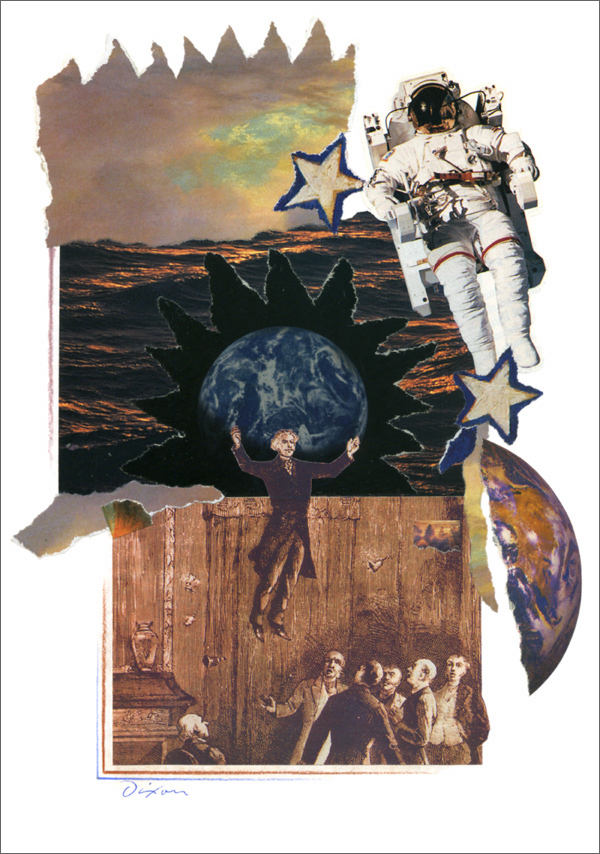
Untitled (Just Another Prophesy)
journal collage by J A Dixon
8.5 x 11 inches, not for sale
Posted in Collage, Experiments, Influences, Ingredients, J A Dixon, J Cornell, Journal, K Schwitters, M Ernst, Merz, Methodology, Priorities | No Comments »
Monday, February 11th, 2013
“From the beginning he had responded to the avant-garde developments of his time with admirable swiftness and sureness. It is hard to think of another American artist who was receptive to so many different art movements or who managed to win the admiration of everyone from the Surrealists in the 1940s to the Abstract Expressionists in the 1950s to the Pop Artists in the 1960s. Artists who agreed on little else agreed on Cornell.”
—Deborah Solomon
“The central themes of Pop Art were sub-culture, folk cultures, media imagery, new technologies, design, the consumer goods and engineering industries, the inter-relationships between these phenomena and their effect on human beings.”
—Tilman Osterwold
Osterwold’s analysis suggests that traditions, fashions, and even avant-gardist achievements could no longer be the norm after Pop Art, which swept away the boundaries of artistic development with its focus on a “consciously perceived and reflected present-day existence.” Having just finished Deborah Solomon’s biography of Joseph Cornell (Utopia Park: The Life and Work of Joseph Cornell), I am struck by how Cornell anticipated Pop Art with his focus on the appropriated elements of mass culture and his various obsessions with celebrities, while at the same time demonstrating an abiding indifference to the cult of personal fame so typically associated with the movement. Walter Hopps stated that Cornell was “Schwitters’ greatest successor.” Cornell was certainly aware of Schwitters, for he was highly cognizant of nearly everything about the onrushing stream of modern art (in contrast to the misconception that he was some sort of urban hermit), but the precise lineage of artistic influence may never be fully known. Perhaps it was Cornell’s connection with Max Ernst that is a key factor. In my opinion, Ernst was not a giant of 20th-century collage, but did have a vital influence on the genesis of Cornell’s art. It is well recognized that Joseph began and ended his unique body of work with the medium of collage. One of the things that astonishes me is how he could be so attuned to the advancing frontier of present-day art (often staying a step or two ahead of it) and, at the same time, carry such a personal dysfunction that derived from the driving intensity of his inner world. Was that the nature of his genius? At any rate, his strange but amazing ability to synthesize powerful emotional and cultural content by inventing (virtually from scratch) a distilled form of assemblage continues to set the standard for almost everything in the mix of media that has followed in its wake. Hardly a day goes by that I don’t observe an artwork that can be traced directly to his seminal vision. But rarely do I see another artist infuse their juxtapositions with a rich symbolism to compare favorably with his complex associations. Most of the art I see with an obvious Cornellian tone owes more to surrealist automatism or atmospheric illustration than to the intricate blend of embedded meaning and refined intuition that characterized his enduring originality.
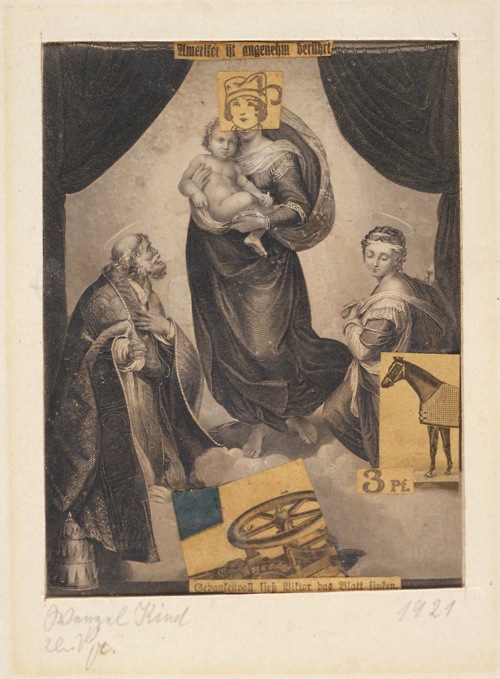
Knave Child
Kurt Schwitters, 1921
Collage on paper
Sprengel Museum, Hannover.
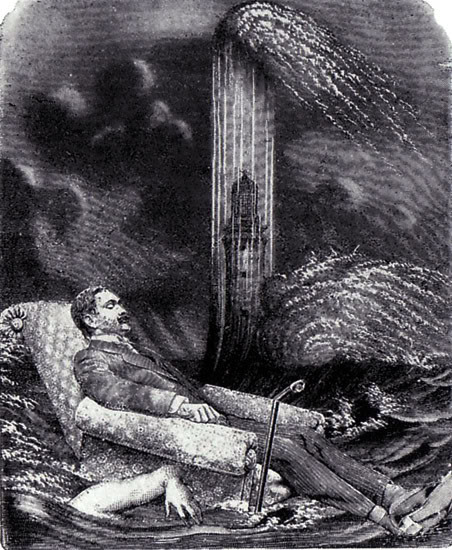
plate from La Femme 100 Têtes
Max Ernst, 1929
Collage novel
Published Éditions du Carrefour, Paris
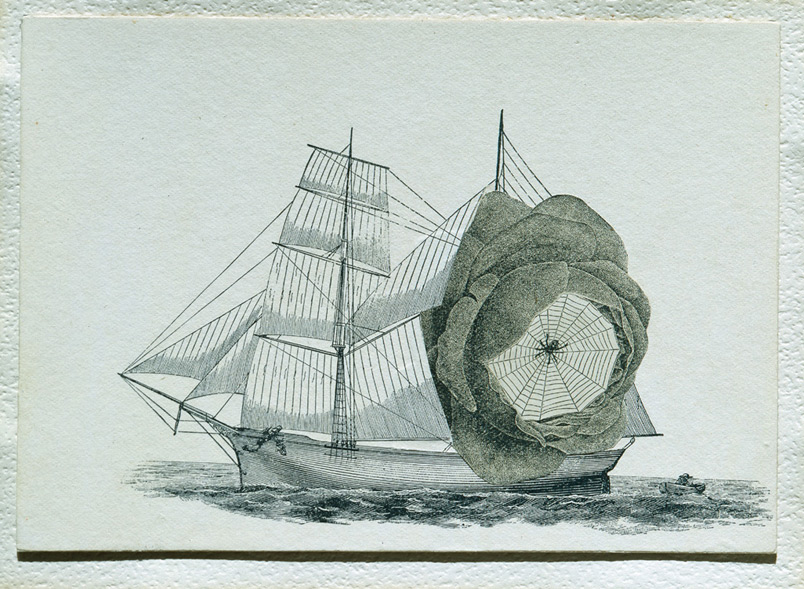
Untitled (Schooner)
Joseph Cornell, 1931
Collage on paperboard
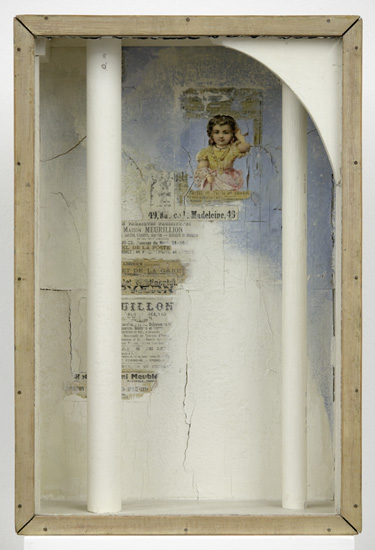
Untitled (Girl and Two Columns)
Joseph Cornell, c. 1950
Glass, wood, tempera and printed paper collage
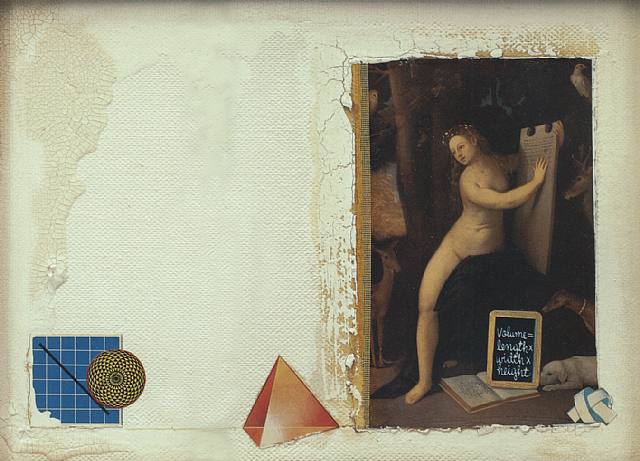
Circe III — Surface and Volume in Nature
Joseph Cornell, c. 1961-66
Collage on masonite
Posted in Assemblage, Collage, Dada, Expressionism, Illustration, Influences, Ingredients, J Cornell, K Schwitters, Links, M Ernst, Pop Art, Surrealism, Symbolism | No Comments »
Tuesday, January 1st, 2013
”Every man should be born again on the first day of January. Start with a fresh page. Take up one hole more in the buckle if necessary, or let down one, according to circumstances; but on the first day of January let every man gird himself once more, with his face to the front, and take no interest in the things that were and are past.”
— Henry Ward Beecher
“Finish each day and be done with it. You have done what you could. Some blunders and absurdities no doubt crept in; forget them as soon as you can. Tomorrow is a new day; begin it well and serenely and with too high a spirit to be encumbered with your old nonsense.”
— Ralph Waldo Emerson (thanks to four corners design)
It is interesting to see the contrasts inherent in various discussions about setting New Year’s resolutions. I think that most people who make them keep the practice to themselves, and the ones who do not are prompted to explain why, often coming from a position that seems cynical or overly critical to me. To be fair, some are simply being practical when they question the efficacy. For those who go out of their way to sow seeds of disdain for the customary list: it’s not about now long it stays viable, or about the resulting success rate, or whether it retains meaning in a culture where overt self-improvement carries a tinge of “fuddy-duddy-ness.” For me it’s about one’s mindset at the cyclical cusp. Is it not just “the thought that counts.” The thought becomes a renewal of self-belief, expressed in multiple line-items of striving. It requires introspection, evaluation, discernment, and commitment— hardly fashionable, to be sure. As an artist, I know that resolutions have worked for me at some level, just as they have for other aspects of my personal discipline (the effort to stop smoking, quit refined sweeteners, or get into marathon condition all began with a New Year’s Day pledge). The bad rap on resolutions probably has a lot to do with the familiar failure to abstain, and that’s understandable, given the nature of human behavior. For the most part, the average person underestimates the value of failure as a stepping stone to achievement. Some of the best insight I’ve read on the subject has been written and shared by choreographer Twyla Tharp. For a creative individual, positive resolutions can be an aid to tackling new challenges. Perhaps it is better to attempt a new ritual of focusing on priorities rather than resolving to banish procrastination, for example. Detrimental patterns can more effectively be overcome if one replaces them with beneficial habits. If a promise to oneself on January the First will help, I’m all for it.

Majestic Fetch
collage miniature by J A Dixon
6 x 6 inches
• S O L D
Posted in 1) Available!, Holidays, Influences, J A Dixon, Links, Priorities, T Tharp | No Comments »
Friday, December 28th, 2012
“Whatever an artist’s personal feelings are, as soon as an artist fills a certain area on the canvas or circumscribes it, he becomes historical. He acts from or upon other artists.”
— Willem De Kooning
“You can never see too many things in a work of art. Itself, the work is a means for discovering what is already within us. The true work of art is more than its creator; it is always beyond him; soon it enters another orbit not his, because the artist changes, he dies, while the work lives in others.”
— Michel Seuphor
As I look back on six months of producing this site, I recognize that there are probably only a handful of people who currently pay a visit. To those of you who do, please accept a sincere tip of the hat. I hope that you find my periodic entries to be stimuli worthy of your time. Perhaps 2013 will bring a wider audience.
Collage is a distinctively collaborative medium, at times directly, but always indirectly. We are continuously interacting with those responsible for the ingredients we value enough to incorporate into a work. They might include one of the finest masters of the brush, an outstanding photographer, a bull-pen illustrator, an obscure commercial artist, or an anonymous shipping-carton keyliner. All that matters is this: Each has in some way caught hold of our eye, mind, or heart. Each has become an influence and unwitting contributor. For reasons not entirely clear, some of us attempt to have a more active effect on the state of our art by regularly making words, too. Allow me to bring a few stimulating blogs to your attention, if you haven’t already discovered them—
matthew rose studio
kathleen o’brien studio
a collage a day
daily collage project
with scissors by hand
paper with a past
every day should be a red letter day
lynn whipple’s blog
janice mcdonald collage art studio
four corners design
the altered page
collage clearinghouse
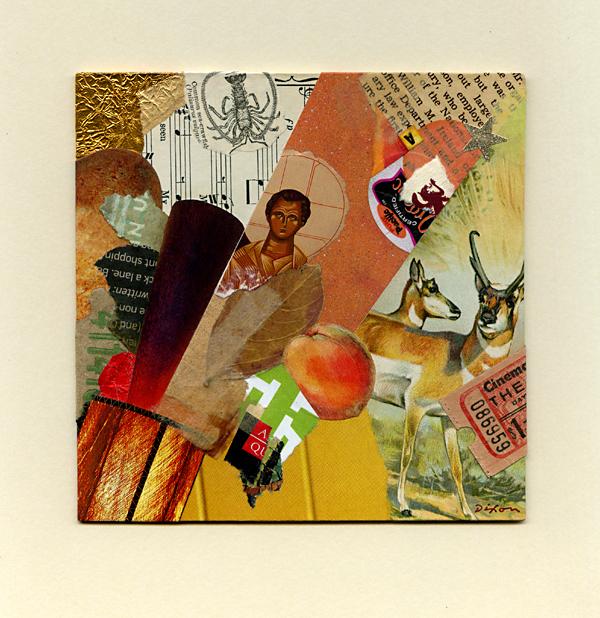
By Heaven’s Good Grace
collage miniature by J A Dixon
5 x 5 inches
Purchase this artwork!
Posted in 1) Available!, Artists/Collage, Collage, Influences, Ingredients, J A Dixon, K O’Brien, L T Holmes, Links, M Rose, R Plowman | 1 Comment »
Sunday, December 9th, 2012
“Any true artist is putting down the most accurate formula he can for what he perceives … The truth is the truth and you don’t want to change it to make it more palatable to reach more people.”
— Robert Motherwell
I frequently make reference to figures who have made their mark on art history, but I also find the work of my collage contemporaries very stimulating. An astonishing number of artists are exploring this vibrant medium who remain true to a keen perception that is beyond an art-buying public looking for familiar effects. This is nothing new, and presents a problem only for those who attempt to gain wide popularity. Occasionally, I am lured by a collage that has made a clear stab at shock, irony, or absurdity. These evocative goals, or some level of social commentary, are worthy objectives for collage as an art form (for which it can be strongly suited). They are among the different approaches to an orientation that Laura T Holmes refers to as “intentional design.” At any rate, I will usually set aside admiration for a conceptual process and re-focus on the visual aesthetics that continuously capture my interest: color, shape, texture, depth, rhythm, resonance, counterpoint, and compositional harmony. So much the better if layers of symbolic meaning emerge, and an observer brings his or her individual responses to the finished result.

Broken Qualifications
collage miniature by J A Dixon
6 x 8 inches
see the revised version
Posted in Collage, Influences, J A Dixon, L T Holmes, Methodology, Symbolism | No Comments »
Saturday, December 8th, 2012
“He spread flour and water over the paper, then moved and shuffled and manipulated his scraps of paper around in the paste…. Finally, he removed the excess paste with a damp rag, leaving some like an overglaze in places where he wanted to veil or mute a part of the color.”
— Charlotte Weidler
It has been more than a year since I had the humbling opportunity to study dozens of Kurt Schwitters originals at the Berkeley Art Museum. I read the description by the art historian Charlotte Weidler that same day, but I only recently decided to experiment with the paste method she observed. I have always worked with a variety of adhesives, and I often combine more than one in a single collage, never hesitating to literally mix them together (white glue + acrylic varnish, for example). I was impressed with how good some of Kurt’s compositions had held together after 70 to 80 years. I dug out a small package of paper-hanger’s wheat paste acquired in the 1970s, with the new intention of using it to produce a collage on canvas that would stand on its own as an object when finished. Although I expected to coat the final surface later with gel medium, for my first piece based on using the same adhesive as the pioneering artist, I was mainly interested in how wheat paste would affect my process.
The artwork is undone, but I share one of my separate experiments below. I could not be more pleased with the results of this approach. The paste dries slowly. This allows for repositioning, easy removal of excess, and it cures to a flat, velvety finish. I am especially pleased with how conducive it is to manipulating coated paper torn from magazines, an ingredient I am quite fond of. I lightly sand the reverse side, adding a bit of white glue to the paste for good measure, and, using this hand-pasting technique, I have never found “mag scrap” more easy to work with. It may not seem like a big deal to those who attend diverse workshops and demonstrations, but, as a self-taught collage artist, it feels like a significant breakthrough to me.
Now, the only question that remains is one of durability. The seminal works of K.S. show every sign of lasting a century in decent shape, but I am no museum expert, nor have I been as fixated on archival longevity as some collage artists I know. I expect my creations to age, perhaps in unexpected ways. This reminds me of an online discussion not long ago about using elements taken from newspapers. Many collage artists may share my expectation that a newsprint ingredient will simply mature as nature sees fit, adding a certain “wabi-sabi” aspect to a work of art that relies on found material. Who knows what Picasso or Braque thought about the nature of impermanence when each created their first collage with that famous wood-grain paper found in a store? Or, for that matter, what Schwitters himself thought when— with seemingly little regard for acid-free niceties —he built the enduring concepts of Merz on the detritus of ordinary life?

There I Was
collage experiment by J A Dixon
8.75 x 11.5 inches, not for sale
Posted in Collage, Demonstrations, Exhibitions, Experiments, G Braque, Influences, Ingredients, J A Dixon, K Schwitters, Merz, Methodology, P Picasso, Technique | No Comments »
Wednesday, November 14th, 2012
“Man himself is mute, and it is the image that speaks. For it is obvious that the image alone can keep pace with nature.”
—Boris Pasternak
Those who speak or write as though they understand everything about this medium do not know what they are talking about. But, to be honest, I have never met anyone who behaves that way, so perhaps my opening declaration is meaningless. Sometimes it is even difficult to classify what we do as artists in order to place the effort in some category. I just encountered an interesting chunk of round-table discourse by a new online discussion group struggling to define their area of focus. Most distinctions made between what artists call collage, montage, assemblage, construction, layerism, mixed-media, digital art, illustration, or graphic design are somewhat arbitrary, and we continue to see new terms coined by those who hope to distinguish what they perceive as a unique approach. At any rate, the intent of the artist is central. Clearly, definitions in art are rarely necessary except when attempting to trace a cross-pollination or lineage of influences, and when an organized effort or exhibition requires mutually acknowledged parameters. Additionally, there are always other important considerations to discuss, such as: What is an original? What is the relationship between process and artifact? What is the purpose of reproduction? Does a nomenclature based on exclusion have intellectual validity, or is it simply an adjunct to merchandising?
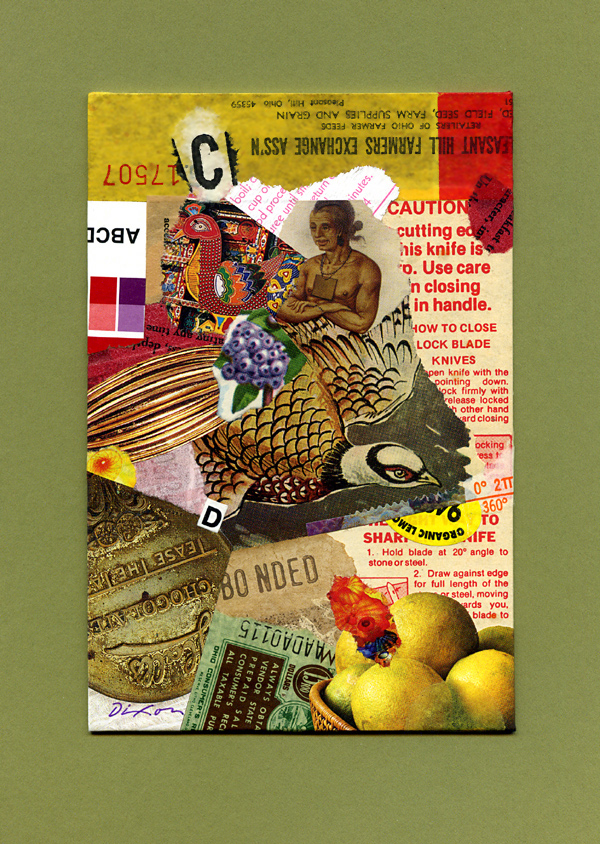
A likely story indeed!
collage miniature by J A Dixon
4 x 6 inches
Purchase this artwork!
Posted in 1) Available!, Assemblage, Collage, Combined Mediums, Graphic Design, Illustration, Influences, J A Dixon, Methodology | No Comments »
Saturday, October 27th, 2012
“I value sense and nonsense alike. I favor nonsense, but that is a personal matter.”
— Kurt Schwitters
When creating a collage, there is no right or wrong approach, but I can’t help but notice the extent to which some artists go in their obvious effort to be clever. Whether one seeks the visual pun, an intellectual twist, or utter shock value, I think all of us would hope to avoid a result that looks too “gimmicky.” For many of us, the goal is to find a desirable place on a spectrum that extends from the fully honed concept to the purely unconscious response. There are times when the progression from start to finish is a smooth, natural flow. More often than not, the process becomes a balancing act of decisions.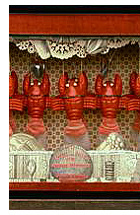 The artist weighs the various relationships between layers of overt connotation and covert significance. Blending levels of stark clarity with obscurity, insinuation, and nuance is what gives the medium of collage its distinctive power.
The artist weighs the various relationships between layers of overt connotation and covert significance. Blending levels of stark clarity with obscurity, insinuation, and nuance is what gives the medium of collage its distinctive power.
In The Essential Joseph Cornell, Ingrid Schaffner delineates the various threads of underlying meaning in Cornell’s “A Pantry Ballet (for Jacques Offenbach),” and how the artist weaves together French Romantic poetry, Lewis Carroll, lobsters, metaphysics, and the once-scandalous cancan. She explains how his work “was built on the power of association and was so well constructed that it is less essential for us to understand all the references than it is to let our mind wander and play with the images.” There is perhaps no artist who influenced the middle decades of the hundred-year history of collage more than Cornell. His constructions demonstrate just how seamless the balance of conscious and subliminal meaning can become in a work of art.
I like to produce compositions without the motive force of intention, but I also enjoy working with an organizing idea or theme. During the course of its creation, a collage may rely on either principle. A piece might begin as sheer abstraction and evolve toward symbolic implications. On the other hand, it might begin with a mental construct that invites other types of intuition and gut reactions. The essence of collage is complex, synergistic, alchemical. Let us all make more!
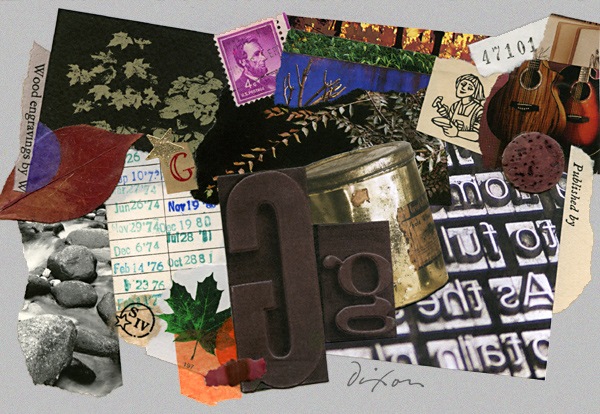
Cyclic Attraction
collage miniature by J A Dixon
7.75 x 3.375 inches
collection of G Zeitz
Posted in Assemblage, Collage, Influences, J A Dixon, J Cornell, K Schwitters, Methodology, Symbolism | No Comments »
Wednesday, October 3rd, 2012
“This is the modern attitude—reactions are based on intellect and preconceived ideas instead of a response to natural, immediate experience. Art is the last refuge. It need not
be rationalized.”
—Harlan Hubbard
There is often a direct relationship between a collage and Nature, especially when ingredient elements are drawn from the organic or botanical wonders that surround us. Certainly, there is no way to classify all the indirect relationships, whether they involve images of the natural world or structures that reflect the cosmic order. Frequently, the quality of found material itself conveys the very essence of natural impermanence and the cycles of creation and decomposition. In the final analysis, can there be anything more natural than a spontaneity of eye, hand, and the intuitive psyche?

By Dint of Maple
collage miniature by J A Dixon
collection of Wesley W Bates
Posted in Collage, Haus of Cards, Influences, Ingredients, J A Dixon | No Comments »
Saturday, September 29th, 2012
“To say that Kurt Schwitters was an amazingly versatile artist and anticipated much is such an absurd understatement that the remark is almost Dada.”
—Walter Hopps
“And so you will understand why we have had enough of Dada. The mirror that indignantly rejects your worthy countenance, that in mirroring it banishes it, such a mirror does not love you, it is in love with the very opposite.”
—Kurt Schwitters
To perpetually imitate KS is to be as unlike him as one could conceive. He was always pushing forward into the untried. But it is not for every artist to cross a boundary into the unknown. Some of us might be better suited to settling the frontier. There may be some among us more appropriately equipped to continue investigating the discoveries of a pioneering original— by sharing these visual concepts with a broader audience, by weaving them into a greater tapestry of the visual landscape, and, with a bit of luck, by finding a way to fuse our unique perspective with what has been handed off to us, in order to express new ideas that further cultivate a valuation of the past.
I am not an expert on Dada or the relationship of Schwitters with the phenomenon. I am always learning more. I just know that he was never fully accepted by the movement at its peak, and that he was compelled to articulate his own vision of Merz. Perhaps much of it relates to Fascist oppression and the resulting geographic disruption, but I’ve always believed there was more to it than that. More important to me is an ongoing effort to unravel the underlying differences. A certain veneration for painting, design, and the aesthetics of beauty probably set KS apart from some of his rejectionist or surrealist contemporaries, but that is what gives his creations a unique, seminal power for me and for others. His perseverance in the face of daunting circumstances and a professed goal of “creating relationships, preferably between all things in the world” fly in the face of a nihilist orientation. Although I remain awed by surrealism in collage, and I am as tickled by irreverent juxtapositions as the next guy, there is an inherent pessimism or metaphysical anarchy in the “art of weirdness” that never seems to resonate with my deepest creative urge. I cannot say that I fully understand that, or that I am not occasionally moved to place a fish head on a reclining nude or mask a face with a front-loading washer. Is it even productive for me to engage in such self-analysis? Or, is it important only to submit to the most undeniable inner motivations when in the studio, sorting through another pile of visual fragments that await an intuitive response?

Unconditional Surrender
collage artifact by J A Dixon
collection of Nancy and Charles Martindale
Posted in Artifacts, Collage, Dada, Influences, J A Dixon, K Schwitters, Merz, Surrealism | No Comments »












 The artist weighs the various relationships between layers of overt connotation and covert significance. Blending levels of stark clarity with obscurity, insinuation, and nuance is what gives the medium of collage its distinctive power.
The artist weighs the various relationships between layers of overt connotation and covert significance. Blending levels of stark clarity with obscurity, insinuation, and nuance is what gives the medium of collage its distinctive power.


